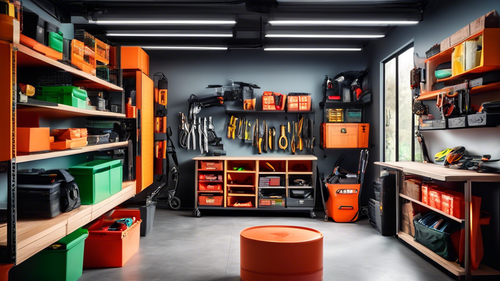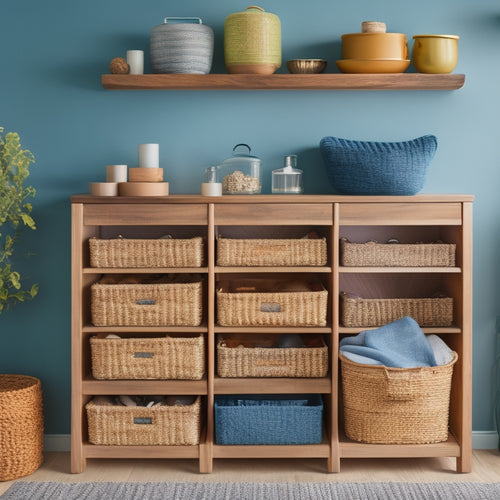
Transform Your Closet With Expert Organization Tips
Share
Transform your closet into a haven of tranquility by implementing expert organization tips. Begin by decluttering your closet essentials, categorizing items into three piles: keep, donate/sell, and discard. Streamline your closet to reduce decision fatigue and save time. Next, maximize closet storage space by measuring and mapping dimensions, utilizing vertical space, and choosing multi-functional storage solutions. Finally, create a functional closet system by allocating zones for different items, implementing a seasonal rotation system, and incorporating clever storage solutions. By following these steps, you'll be well on your way to crafting a clutter-free space that works efficiently – and there's more to explore.
Key Takeaways
• Categorize clothes into keep, donate/sell, and discard piles to declutter your closet and reduce decision fatigue.
• Measure your closet space to identify areas for improvement and optimize storage potential with a well-planned layout.
• Implement a functional closet system with zones for different clothing types and accessories to maintain a clutter-free space.
• Utilize vertical space with shelves, hooks, or storage units to maximize storage capacity and create a more organized closet.
• Adopt a seasonal rotation system to store out-of-season items and keep your closet organized and efficiently functional.
Decluttering Your Closet Essentials
Prior to delving into the organizational process, it is vital to purge your closet of unnecessary items. To accomplish this, begin by categorizing your clothes into three piles: items to keep, items to donate or sell, and items to discard.
This decluttering step is essential in organizing your wardrobe, as it allows you to focus on the items that bring value to your life. Be ruthless – if you haven't worn it in the past year, it's likely time to let it go.
Implementing these decluttering tips will enable you to streamline your closet, reducing decision fatigue and saving time in the long run. By eliminating the unnecessary, you'll be left with a curated collection of clothes that spark joy and make getting dressed a breeze.
Maximizing Closet Storage Space
Optimizing closet storage space requires a thoughtful assessment of your closet's dimensions, shelving, and existing storage solutions to create a functional and aesthetically pleasing environment. A well-planned closet layout is essential to maximize storage capacity.
Consider the following key factors to optimize your closet's storage potential:
-
Measure and map: Measure your closet's dimensions and map out the space to identify areas for improvement.
-
Utilize vertical space: Make the most of your closet's vertical space by installing shelves, hooks, or storage units that go up to the ceiling.
-
Choose multi-functional storage solutions: Select storage solutions that serve multiple purposes, such as shelves with built-in drawers or hanging rods with built-in shelves.
Creating a Functional Closet System
A functional closet system is built on a foundation of intentional design, where every component, from shelves to bins, serves a specific purpose and works in harmony to create a seamless storage and retrieval experience.
A well-planned closet layout is essential, with zones allocated for different types of clothing and accessories. Implementing a seasonal rotation system guarantees that out-of-season items are stored away, freeing up space for current favorites.
This strategic approach enables you to maintain a clutter-free closet, effortlessly accessing what you need when you need it. By incorporating clever storage solutions and thoughtful design elements, you can create a closet that works efficiently and effectively, saving you time and reducing stress.
Frequently Asked Questions
How Do I Maintain My Organized Closet Over Time?
To maintain your organized closet, implement a seasonal refresh every 3-4 months to reassess and adjust your space. Foster habit formation by scheduling regular tidying sessions and adopting a "one in, one out" policy to prevent clutter accumulation.
Can I Organize My Closet if I Have Limited Mobility or Disabilities?
Just as a master navigator charts a course through treacherous waters, individuals with limited mobility or disabilities can harness accessible tools and adaptive methods to conquer closet organization, ensuring a smooth sail to a clutter-free sanctuary.
What if I'm Attached to Sentimental Clothing Items?
When sentimental clothing items hinder decluttering, practice emotional detachment by creating Memory Boxes for cherished items, allowing you to preserve memories while freeing up closet space for functional, stylish organization.
How Do I Involve My Family Members in the Organization Process?
'Can chaos be tamed by collective effort?' Indeed, it can. Assign Family Roles to guarantee each member takes ownership, and establish Shared Goals to unite your team in the organization process, fostering a sense of responsibility and collaboration.
Can I Organize a Closet With an Unusual or Irregular Shape?
When faced with an irregularly shaped closet, utilize corner shelves to maximize storage in tight spaces and curved rods to accommodate unique angles, ensuring a functional and aesthetically pleasing organization system.
Conclusion
To sum up, transforming a cluttered closet into a serene and functional space requires a strategic approach. By understanding the reasons behind clothing accumulation and implementing a 5-step process, individuals can create a tailored organization system that suits their unique needs.
Did you know that the average American spends approximately 60 hours per year searching for lost items, with a closet being a primary culprit? By applying expert organization tips, individuals can reclaim their closet space and experience the benefits of a more organized and peaceful living environment.
Related Posts
-

Clever Ways to Conceal Garage Clutter
Raise your hand if you have a garage full of clutter! Don't worry, you're not alone. A messy garage is a common p...
-

Create Your Dream Closet With Online Tools
You can bring your dream closet to life with online tools that let you envision, design, and customize your ideal spa...
-

Declutter Your Drawers: 10 Genius Storage Hacks
You can breathe new life into your cluttered drawers by implementing a few genius storage hacks. Start by maximizing ...


